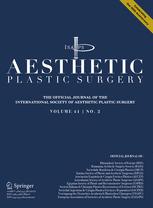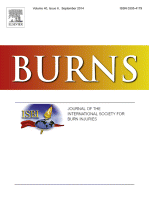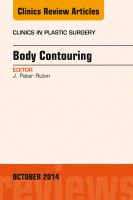Groth, A; Graf, R.
Aesthetic Plastic Surgery, February 2020, Volume 44, Issue 1
 Breast implant-associated anaplastic large cell lymphoma (BIA-ALCL) is an uncommon T-cell, CD-30+/ALK lymphoma. Late (9 years) periprosthetic fluid (seroma) is the most common presentation (90% of the cases). A combination of textured breast implant, bacterial contamination, and genetic predisposition seems to be necessary for BIA-ALCL to occur. There are 35 million patients with implants in the world, and at the present moment, 573 cases of BIA-ALCL have been reported.
Breast implant-associated anaplastic large cell lymphoma (BIA-ALCL) is an uncommon T-cell, CD-30+/ALK lymphoma. Late (9 years) periprosthetic fluid (seroma) is the most common presentation (90% of the cases). A combination of textured breast implant, bacterial contamination, and genetic predisposition seems to be necessary for BIA-ALCL to occur. There are 35 million patients with implants in the world, and at the present moment, 573 cases of BIA-ALCL have been reported.
 Major thermal injury induces profound metabolic derangements secondary to an inflammatory “stress-induced” hormonal environment. Several pharmacological interventions have been tested in an effort to halt the hypermetabolic response to severe burns. Insulin, insulin growth factor 1, insulin growth factor binding protein 3, metformin, human growth hormone, thyroid hormones, testosterone, oxandrolone, and propranolol, among others, have been proposed to have anabolic or anticatabolic effects.
Major thermal injury induces profound metabolic derangements secondary to an inflammatory “stress-induced” hormonal environment. Several pharmacological interventions have been tested in an effort to halt the hypermetabolic response to severe burns. Insulin, insulin growth factor 1, insulin growth factor binding protein 3, metformin, human growth hormone, thyroid hormones, testosterone, oxandrolone, and propranolol, among others, have been proposed to have anabolic or anticatabolic effects. Both thromboembolism and excessive bleeding following breast surgery could result in multiple surgical procedures, breast reconstruction failure, or even mortality. This systematic review and meta-analysis of 5617 female breast surgery patients compared pharmacological prophylaxis to nonpharmacological prophylaxis interventions during the pre-, intra-, and/or postoperative time points and evaluated associated outcomes and complications.
Both thromboembolism and excessive bleeding following breast surgery could result in multiple surgical procedures, breast reconstruction failure, or even mortality. This systematic review and meta-analysis of 5617 female breast surgery patients compared pharmacological prophylaxis to nonpharmacological prophylaxis interventions during the pre-, intra-, and/or postoperative time points and evaluated associated outcomes and complications. Smoking is considered to be a significant risk factor for the development of postoperative complications after various surgical procedures, mainly by limiting oxygen delivery to tissues. Evidence on the collective impact of smoking in aesthetic procedure outcomes is scarce. The aim of this study is to evaluate the current evidence on the association between smoking and postoperative outcomes in patients who underwent common elective procedures in plastic surgery.
Smoking is considered to be a significant risk factor for the development of postoperative complications after various surgical procedures, mainly by limiting oxygen delivery to tissues. Evidence on the collective impact of smoking in aesthetic procedure outcomes is scarce. The aim of this study is to evaluate the current evidence on the association between smoking and postoperative outcomes in patients who underwent common elective procedures in plastic surgery. Early excision of burns reduces the incidence of local and systemic infections caused by colonising microorganisms, and reduces mortality and length of hospital stay. Appropriate antibiotic prophylaxis can reduce the risk of postoperative wound infections and skin graft loss. Antibiotic selection should be based on likely pathogens. However, there are few studies that have investigated the early pathogenic colonisers of acute burn wounds.
Early excision of burns reduces the incidence of local and systemic infections caused by colonising microorganisms, and reduces mortality and length of hospital stay. Appropriate antibiotic prophylaxis can reduce the risk of postoperative wound infections and skin graft loss. Antibiotic selection should be based on likely pathogens. However, there are few studies that have investigated the early pathogenic colonisers of acute burn wounds. This patient safety article discusses strategies to prevent, diagnose, and manage complications from body contouring surgery. Preoperative, intraoperative, and postoperative approaches to avoiding, identifying, and treating complications are addressed. Individual complications, such as hematoma, seroma, infection, dehiscence, suture extrusion, deep venous thrombosis, and pulmonary embolism are discussed and a review of complication rates in the body contouring literature is provided. The article addresses procedure-specific complications and pearls to avoiding complications in these cases. Difficult problems such as skin relaxation and management of the disappointed patient are also discussed.
This patient safety article discusses strategies to prevent, diagnose, and manage complications from body contouring surgery. Preoperative, intraoperative, and postoperative approaches to avoiding, identifying, and treating complications are addressed. Individual complications, such as hematoma, seroma, infection, dehiscence, suture extrusion, deep venous thrombosis, and pulmonary embolism are discussed and a review of complication rates in the body contouring literature is provided. The article addresses procedure-specific complications and pearls to avoiding complications in these cases. Difficult problems such as skin relaxation and management of the disappointed patient are also discussed.





 Sitio web publicado el
Sitio web publicado el
Los lectores comentan